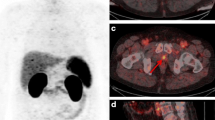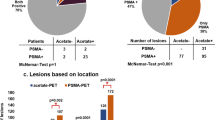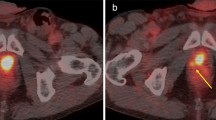Abstract
Purpose
The first aim of the study was to investigate the diagnostic potential of 11C-acetate PET in the early detection of prostate cancer recurrence. A second aim was the evaluation of early and late PET in this context.
Methods
The study population comprised 32 prostate cancer patients with early evidence of relapse after initial radiotherapy (group A) or radical surgery (group B). The median PSA of group A (n=17) patients was 6 ng/ml (range 2.6–30.2) while that of group B (n=15) was 0.4 ng/ml (range 0.08–4.8). Pelvic-abdominal-thoracic PET was started 2 min after injection of 11C-acetate and evaluated after fusion with CT.
Results
Group A: Taking a SUVmax≥2 as the cut-off, PET showed local recurrences in 14/17 patients and two equivocal results. Distant disease was observed in six patients and an equivocal result was obtained in one. Endorectal MRI was positive in 12/12 patients. Biopsy confirmed local recurrence in six of six (100%) patients. PET was positive in five of the six patients with biopsy-proven recurrences, the result in the remaining patient being equivocal. Group B: Among the 15 patients, visual interpretation was positive for local recurrences in five patients and equivocal in four. One obturator lymph node was positive. Endorectal MRI was positive in 11/15 patients and equivocal in two. Positional correlation of positive/equivocal results on PET and endorectal MRI was observed in seven of nine patients. PSA decreased significantly after salvage radiotherapy in 8/14 patients, providing strong evidence for local recurrence. PET of the eight patients responding to RT was positive in three and equivocal in two.
Conclusion
11C-acetate PET was found to be valuable in the early evaluation of prostate cancer relapse. Optimising scanning time and use of modern PET-CT equipment might allow further improvement.




Similar content being viewed by others
References
Schoder H, Larson SM. Positron emission tomography for prostate, bladder, and renal cancer. Semin Nucl Med 2004;34:274–92
Sanz G, Rioja J, Zudaire JJ, Berian JM, Richter JA. PET and prostate cancer. World J Urol 2004;22:351–2
Price DT, Coleman RE, Liao RP, Robertson CN, Polascik TJ, DeGrado TR. Comparison of [18F]fluorocholine and [18F]fluorodeoxyglucose for positron emission tomography of androgen dependent and androgen independent prostate cancer. J Urol 2002;168:273–80
Oyama N, Miller TR, Dehdashti F, Siegel BA, Fischer KC, Michalski JM, et al.11C-acetate PET imaging of prostate cancer: detection of recurrent disease at PSA relapse. J Nucl Med 2003;44:549–55
Kotzerke J, Volkmer BG, Glatting G, van den Hoff J, Gschwend JE, Messer P, et al. Intraindividual comparison of [11C]acetate and [11C]choline PET for detection of metastases of prostate cancer. Nuklearmedizin 2003;42:25–30
Seltzer MA, Jahan SA, Dahlbom M, Sathyamurthy N, Barrio JR, Phelps ME, et al. Combined metabolic imaging using C-11 acetate and FDG PET for the evaluation of patients with suspected recurrent prostate cancer. J Nucl Med 2003;44:132P
Fricke E, Machtens S, Hofmann M, van den Hoff J, Bergh S, Brunkhorst T, et al. Positron emission tomography with11C-acetate and18F-FDG in prostate cancer patients. Eur J Nucl Med Mol Imaging 2003;30:607–11
Yoshimoto M, Waki A, Obata A, Furukawa T, Yonekura Y, Fujibayashi Y. Radiolabeled choline as a proliferation marker: comparison with radiolabeled acetate. Nucl Med Biol 2004;31:859–65
Harisinghani MG, Barentsz J, Hahn PF, Deserno WM, Tabatabaei S, van de Kaa CH, et al. Noninvasive detection of clinically occult lymph-node metastases in prostate cancer. N Engl J Med 2003;348:2491–9
Winter PM, Caruthers SD, Kassner A, Harris TD, Chinen LK, Allen JS, et al. Molecular imaging of angiogenesis in nascent Vx-2 rabbit tumors using a novel alpha(nu)beta3-targeted nanoparticle and 1.5 tesla magnetic resonance imaging. Cancer Res 2003;63:5838–43
Siegel C. Organ-confined prostate cancer: effect of prior transrectal biopsy on endorectal MRI and MR spectroscopic imaging. J Urol 2005;174:569
Brassell SA, Rosner IL, McLeod DG. Update on magnetic resonance imaging, ProstaScint, and novel imaging in prostate cancer. Curr Opin Urol 2005;15:163–6
Cheng GC, Chen MH, Whittington R, Malkowicz SB, Schnall MD, Tomaszewski JE, et al. Clinical utility of endorectal MRI in determining PSA outcome for patients with biopsy Gleason score 7, PSA <or=10, and clinically localized prostate cancer. Int J Radiat Oncol Biol Phys 2003;55:64–70
Coakley FV, Teh HS, Qayyum A, Swanson MG, Lu Y, Roach M, et al. Endorectal MR imaging and MR spectroscopic imaging for locally recurrent prostate cancer after external beam radiation therapy: preliminary experience. Radiology 2004;233:441–8
Cox JD, Gallagher MJ, Hammond EH, Kaplan RS, Schellhammer PF. Consensus statements on radiation therapy of prostate cancer: guidelines for prostate re-biopsy after radiation and for radiation therapy with rising prostate-specific antigen levels after radical prostatectomy. American Society for Therapeutic Radiology and Oncology Consensus Panel. J Clin Oncol 1999;17:1155
Ward JF, Slezak JM, Blute ML, Bergstralh EJ, Zincke H. Radical prostatectomy for clinically advanced (cT3) prostate cancer since the advent of prostate-specific antigen testing: 15-year outcome. B J U Int 2005;95:751–6
Winkler MH, Khan FA, Shabir M, Okeke A, Sugiono M, McInerney P, et al. Contemporary update of cancer control after radical prostatectomy in the UK. Br J Cancer 2004;91:1853–7
Ward JF, Zincke H, Bergstralh EJ, Slezak JM, Myers RP, Blute ML. The impact of surgical approach (nerve bundle preservation versus wide local excision) on surgical margins and biochemical recurrence following radical prostatectomy. J Urol 2004;172:1328–32
Ward JF, Moul JW. Biochemical recurrence after definitive prostate cancer therapy. Part I: defining and localizing biochemical recurrence of prostate cancer. Curr Opin Urol 2005;15:181–6
Ward JF, Moul JW. Biochemical recurrence after definitive prostate cancer therapy. Part II: treatment strategies for biochemical recurrence of prostate cancer. Curr Opin Urol 2005;15:187–95
D’Amico AV, Whittington R, Malkowicz SB, Schultz D, Blank K, Broderick GA, et al. Biochemical outcome after radical prostatectomy, external beam radiation therapy, or interstitial radiation therapy for clinically localized prostate cancer. JAMA 1998;280:969–74
Freedland SJ, Sutter ME, Dorey F, Aronson WJ. Defining the ideal cutpoint for determining PSA recurrence after radical prostatectomy. Prostate-specific antigen. Urology 2003;61:365–9
Consensus statement: guidelines for PSA following radiation therapy. American Society for Therapeutic Radiology and Oncology Consensus Panel. Int J Radiat Oncol Biol Phys 1997;37:1035–41
Horwitz EM, Thames HD, Kuban DA, Levy LB, Kupelian PA, Martinez AA, et al. Definitions of biochemical failure that best predict clinical failure in patients with prostate cancer treated with external beam radiation alone: a multi-institutional pooled analysis. J Urol 2005;173:797–802
Stephenson AJ, Shariat SF, Zelefsky MJ, Kattan MW, Butler EB, Teh BS, et al. Salvage radiotherapy for recurrent prostate cancer after radical prostatectomy. JAMA 2004;291:1325–32
Dimitrakopoulou-Strauss A, Strauss LG. PET imaging of prostate cancer with11 C-acetate. J Nucl Med 2003;44:556–8
Kotzerke J, Volkmer BG, Neumaier B, Gschwend JE, Hautmann RE, Reske SN. Carbon-11 acetate positron emission tomography can detect local recurrence of prostate cancer. Eur J Nucl Med Mol Imaging 2002;29:1380–4
Soloviev D, Tamburella C. Technical report: captive solvent [11C]acetate synthesis in GMP conditions. Appl Radiat Isotopes 2006; in press
Roeda D, Dolle F, Crouzel C. An improvement of11C acetate synthesis-non-radioactive contaminants by irradiation-induced species emanating from the11C carbon dioxide production target. Appl Radiat Isotopes 2002;57:857–60
Davenport RJ, Dowsett K, Pike VW. A simple technique for the automated production of no-carrier-added [1–11C]acetate. Appl Radiat Isotopes 1997;48:1117–20
Bailey DL, Young H, Bloomfield PM, Meikle SR, Glass D, Myers MG, et al. ECAT ART—a continuously rotating PET camera: performance characteristics, initial clinical studies, and installation considerations in a nuclear medicine department. Eur J Nucl Med 1997;24:6–15
Townsend DW, Beyer T, Jerin J, Watson CC, Young J, Nutt R. The ECAT ART scanner for positron emission tomography. 1. Improvements in performance characteristics. Clin Positron Imaging 1999;2:5–15
Brix G, Lechel U, Glatting G, Ziegler SI, Munzing W, Muller SP, et al. Radiation exposure of patients undergoing whole-body dual-modality18F-FDG PET/CT examinations. J Nucl Med 2005;46:608–13
Zaidi H, Gomez M, Boudraa A, Slosman DO. Fuzzy clustering-based segmented attenuation correction in whole-body PET imaging. Phys Med Biol 2002;47:1143–60
Allal AS, Dulguerov P, Allaoua M, Haenggeli CA, El-Ghazi EA, Lehmann W, et al. Standardized uptake value of 2-[18F]fluoro-2-deoxy-D-glucose in predicting outcome in head and neck carcinomas treated by radiotherapy with or without chemotherapy. J Clin Oncol 2002;20:1398–404
Malpica A, Matisic JP, Niekirk DV, Crum CP, Staerkel GA, Yamal JM, et al. Kappa statistics to measure interrater and intrarater agreement for 1790 cervical biopsy specimens among twelve pathologists: qualitative histopathologic analysis and methodologic issues. Gynecol Oncol 2005;99:S38–52
Kato T, Tsukamoto E, Kuge Y, Takei T, Shiga T, Shinohara N, et al. Accumulation of [11C] acetate in normal prostate and benign prostatic hyperplasia: comparison with prostate cancer. Eur J Nucl Med Mol Imaging 2002;29:1492–5
Kwee SA, Wei H, Sesterhenn I, Yun D, Coel MN. Localization of primary prostate cancer with dual-phase18F-fluorocholine PET. J Nucl Med 2006;47:262–9
Heinisch M, Dirisamer A, Loidl W, Stoiber F, Gruy B, Haim S, et al. Positron emission tomography/computed tomography with F-18-fluorocholine for restaging of prostate cancer patients: meaningful at PSA <5 ng/ml? Mol Imaging Biol 2006;8:43–8
Schmid DT, John H, Zweifel R, Cservenyak T, Westera G, Goerres GW, et al. Fluorocholine PET/CT in patients with prostate cancer: initial experience. Radiology 2005;235:623–8
Acknowledgements
We acknowledge with thanks the generous donation from the foundation Cellex International that made this study possible. We also express our gratitude to the staff of the services of nuclear medicine and radiology who performed the imaging and to Mrs. Frances Godson for reviewing the manuscript.
Author information
Authors and Affiliations
Corresponding author
Rights and permissions
About this article
Cite this article
Albrecht, S., Buchegger, F., Soloviev, D. et al. 11C-acetate PET in the early evaluation of prostate cancer recurrence. Eur J Nucl Med Mol Imaging 34, 185–196 (2007). https://doi.org/10.1007/s00259-006-0163-x
Received:
Revised:
Accepted:
Published:
Issue Date:
DOI: https://doi.org/10.1007/s00259-006-0163-x




